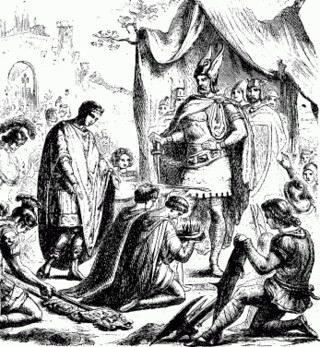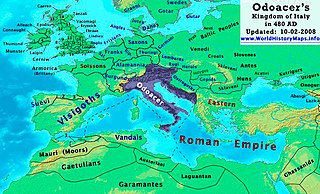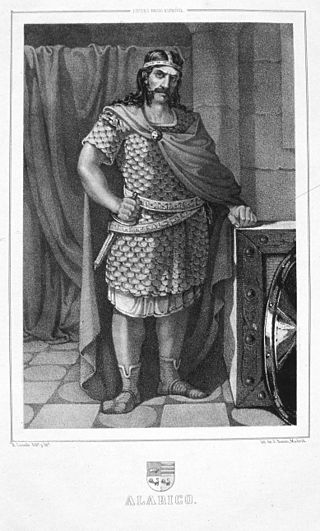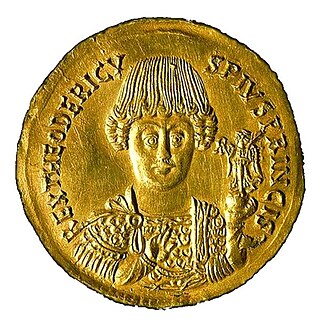Related Research Articles

Year 476 (CDLXXVI) was a leap year starting on Thursday of the Julian calendar. At the time, it was known as the Year of the Consulship of Basiliscus and Armatus. The denomination 476 for this year has been used since the early medieval period, when the Anno Domini calendar era became the prevalent method in Europe for naming years.
The 470s decade ran from January 1, 470, to December 31, 479.
The 430s decade ran from January 1, 430, to December 31, 439.

Year 480 (CDLXXX) was a leap year starting on Tuesday of the Julian calendar. At the time, it was known as the Year of the Consulship of Basilius without colleague. The denomination 480 for this year has been used since the early medieval period, when the Anno Domini calendar era became the prevalent method in Europe for naming years.
The 490s decade ran from January 1, 490, to December 31, 499.
The 450s decade ran from January 1, 450, to December 31, 459.
The 440s decade ran from January 1, 440, to December 31, 449.
The 460s decade ran from January 1, 460, to December 31, 469.

Year 458 (CDLVIII) was a common year starting on Wednesday of the Julian calendar. At the time, it was known as the Year of the Consulship of Maiorianus and Leo. The denomination 458 for this year has been used since the early medieval period, when the Anno Domini calendar era became the prevalent method in Europe for naming years.

Year 466 (CDLXVI) was a common year starting on Saturday of the Julian calendar. At the time, it was known as the Year of the Consulship of Leo and Tatianus. The denomination 466 for this year has been used since the early medieval period, when the Anno Domini calendar era became the prevalent method in Europe for naming years.

Year 484 (CDLXXXIV) was a leap year starting on Sunday of the Julian calendar. At the time, it was known as the Year of the Consulship of Venantius and Theodoricus. The denomination 484 for this year has been used since the early medieval period, when the Anno Domini calendar era became the prevalent method in Europe for naming years.
Year 488 (CDLXXXVIII) was a leap year starting on Friday of the Julian calendar. At the time, it was known as the Year of the Consulship of Ecclesius and Sividius. The denomination 488 for this year has been used since the early medieval period, when the Anno Domini calendar era became the prevalent method in Europe for naming years.

Julius Nepos, or simply Nepos, ruled as Roman emperor of the West from 24 June 474 to 28 August 475. After losing power in Italy, Nepos retreated to his home province of Dalmatia, from which he continued to claim the western imperial title, with recognition from the Eastern Roman Empire, until he was murdered in 480. Though Nepos' successor in Italy, Romulus Augustulus, is traditionally deemed the last western Roman emperor, Nepos is regarded by some historians as the true last emperor of the west, being the last widely recognised claimant to the position.
Year 469 (CDLXIX) was a common year starting on Wednesday of the Julian calendar. At the time, it was known as the Year of the Consulship of Marcianus and Zeno. The denomination 469 for this year has been used since the early medieval period, when the Anno Domini calendar era became the prevalent method in Europe for naming years.

Zeno was Eastern Roman emperor from 474 to 475 and again from 476 to 491. Domestic revolts and religious dissension plagued his reign, which nevertheless succeeded to some extent in foreign issues. His reign saw the end of the Western Roman Empire following the deposition of Romulus Augustus and the death of Julius Nepos, but he was credited with contributing much to stabilising the Eastern Empire.

Aelia Verina was the Empress consort of Leo I of the Eastern Roman Empire. She was a sister of Basiliscus. Her daughter Ariadne was Empress consort of first Zeno and then Anastasius I. Verina was the maternal grandmother of Leo II.

The Ostrogothic Kingdom, officially the Kingdom of Italy, existed under the control of the Germanic Ostrogoths in Italy and neighbouring areas from 493 to 553.
Flavius Marcianus was a member of the Leonid dynasty. The son of the Western emperor Anthemius, Marcianus married Leontia, the daughter of the Eastern Roman emperor Leo I. He was consul twice, and in 479 unsuccessfully attempted to overthrow the emperor Zeno. After his capture he was forced to become a monk; he escaped and raised an army but was defeated and recaptured by Flavius Appalius Illus Trocundes. In 484, when the Isaurian general Illus revolted against Zeno, Marcianus was freed and Illus proclaimed him emperor, before deposing him in favour of Leontius.

The Eastern Roman Empire was ruled by the House of Leo from AD 457, the accession of Leo I, to 518, the death of Anastasius I. The rule of the Leonid dynasty coincided with the rapid decline, collapse and eventual fall of the Western Roman Empire. Following the end of the Western Empire, Emperor Zeno abolished the position of Western Roman Emperor and declared himself the sole Roman Emperor. The Eastern Roman Empire would come to last for several more centuries, and subsequent dynasties would invest large amounts of resources in attempts to retake the western provinces.
References
- ↑ Wickham, Chris (2005). Framing the Early Middle Ages: Europe and the Mediterranean 400-800. OUP Oxford. p. 88.
- ↑ saintpatrickdc.org Archived June 13, 2017, at the Wayback Machine : Saints of March 23
- ↑ "Xiaowendi | emperor of Wei dynasty | Britannica". www.britannica.com. Retrieved 2022-07-15.
- ↑ "Boethius (480-524) - Anicius Manlius Severinus Boetius: Of the consolation of philosophy : in five books / made English and illustrated with notes by the Right Honourable Richard Lord Viscount Preston". www.royalcollection.org.uk. Retrieved 23 June 2018.